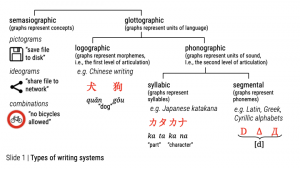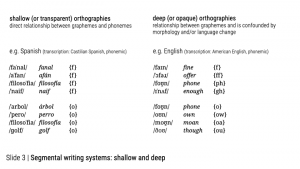The first point of this week’s lecture was to impress on you the fact that writing systems are not an inherent “part” of language, as
- languages can have more than one writing system (e.g. Serbian, whose speakers use both the Latin and the Cyrillic alphabets);
- a speech community can shift from one writing system to another very suddenly (e.g. Turkish, which shifted from Arabic to Latin in 1928);
- changes within a writing system can be decreed by law (as in the case of the German spelling reform),
None of these things are possible with the sound system of a language or with other aspects of linguistic structure.
The second point was to provide an overview of writing systems, as shown in the following slide:
The third point was to point out that English has a segmental writing system, but not a very transparent one – as opposed, for example, to Spanish:
The reasons for the intransparent orthography of English are largely historical. There are four main reasons:
- For many words, the spelling became fixed early, so when the sound system of English changed, the spelling no longer corresponded to the pronunciation – for example dream was pronounced [drɛam] in Old English, which is fairly transparent, and while the pronunciation changed to [driːm] (due to general sound changes in English), the spelling did not change with it, thus becoming intransparent.
- For other words, the spelling was adjusted at some point in an attempt to capture the new pronunciation – depending on when this happened, different ways of representing a sound were used, leading to inconsistencies.
- For yet other words, the spelling was adjusted to match what people thought was the original pronunciation (etymologizing spellings). For example, the word salmon was always pronounced without an [l] – Middle English [saːˈmuːn], Modern English [ˈsæmən], as it was borrowed from Norman French samoun. However, because the ultimate Latin root salmō contains an <l>, this was added to the English spelling in an attempt at etymological authenticity.
- Loan words typically retain their spelling wholly or partially when borrowed into English.
The final point of the lecture was to draw awareness to the fact that it may be useful to have an orthography that does not correspond to the pronunciation very closely, as it means that homophones (words that sound the same but mean different things) can be disambiguated in writing (for example, by, bye and buy. In this sense, English spelling has some properties of logographic writing systems.

